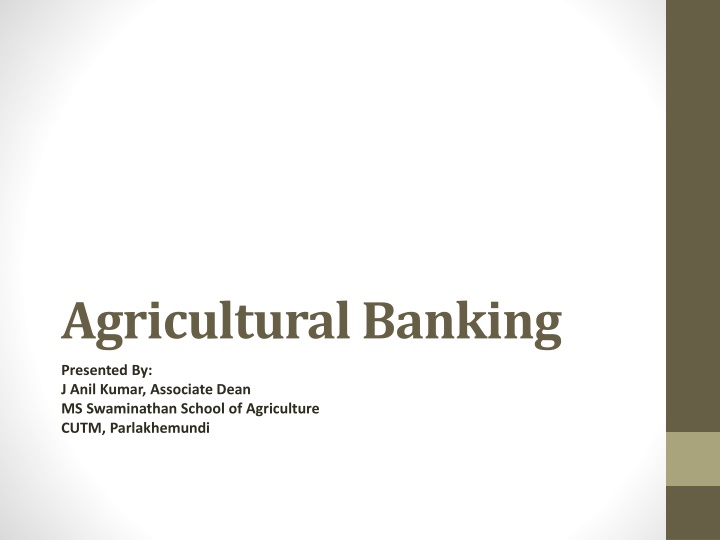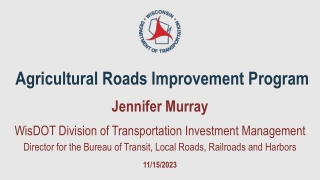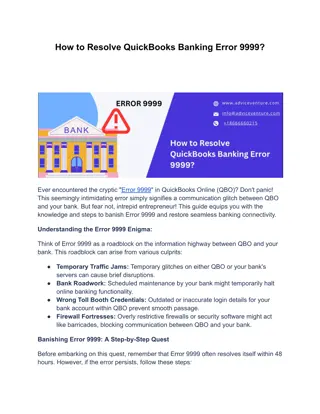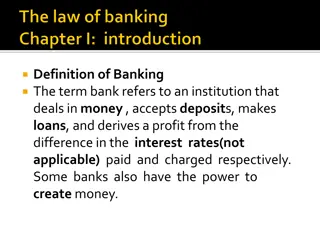
Importance of Agricultural Banking in India
Explore the significance of agricultural banking in India, where the agriculture sector contributes significantly to the GDP and employs a large portion of the workforce. Learn about the history of banking in India, the structure of banks, and the role they play in priority sector lending. Discover how banks provide essential financial services to farmers and rural communities, supporting the backbone of the Indian economy.
Download Presentation

Please find below an Image/Link to download the presentation.
The content on the website is provided AS IS for your information and personal use only. It may not be sold, licensed, or shared on other websites without obtaining consent from the author. If you encounter any issues during the download, it is possible that the publisher has removed the file from their server.
You are allowed to download the files provided on this website for personal or commercial use, subject to the condition that they are used lawfully. All files are the property of their respective owners.
The content on the website is provided AS IS for your information and personal use only. It may not be sold, licensed, or shared on other websites without obtaining consent from the author.
E N D
Presentation Transcript
Agricultural Banking Presented By: J Anil Kumar, Associate Dean MS Swaminathan School of Agriculture CUTM, Parlakhemundi
Indian Agriculture-Significance India produces 275 Million MT of food grains (25% of global food production). Agriculture sector contributes to 20% of the GDP and 10% of country s export earnings of India. Out of a population of 1.27 billion, more than 600 million (50%) are farmers. More than 70% of rural households in India depend of Agriculture for their livelihood. Agriculture accounts for 42% of India s workforce. The total credit disbursal to farm sector in India was over Rs 13 lakh crores in 2019-20.
Sector-wise Growth Rate (%)of GVA at Basic Prices (at 2011-12 constant prices) 100% 8 7.9 6.7 6 3.9 80% 6.7 8.1 8.6 5 7.5 60% 6.9 8.3 11.9 40% 0.8 4.5 4 6.5 6.3 20% 2.4 0.6 0% 2015-16 2016-17 2017-18 2018-19 2019-20 Agriculture Industry Services GVA at Basic Prices
Bank Bank is a financial institution licensed to receive deposits and give loans. Banks are very important part of the economy providing essential services to consumers and businesses. Banks provide a variety of accounts like current and saving Accounts, recurring and fixed deposits. Routine transactions like deposits, withdrawals, transfers, cheque writing and bill payments can be done in a bank. Money stored in most bank accounts is federally insured by DICGC up to Rs 5 Lakhs.
HistoryofBankinginIndia Pre-Independence Stage (Before 1947) II Phase (1947 to 1991) III Phase (1991 & Beyond) ICICI Bank Imperial Bank (SBI) UTI/ Axis Bank Nationalization of RBI HDFC Bank Allahabad Bank IndusInd Bank Nationalization of Banks IDBI Bank Punjab National Bank Global Trust Bank Bank of India Times Bank Formation of Regional Rural Banks Bank of Baroda Bank of Punjab Kotak Mahindra Bank Central Bank of India Yes Bank
Structure of Banks in India Reserve Bank of India Scheduled Bank Non Scheduled Bank Development Bank IFCI Commercial Bank Cooperative Bank Payments Bank Small Finance Bank NABARD EXIM BANK Coastal LAB KBS LAB Subhadra LAB Public Sector Private Sector RRB Foreign NHB SIBDBI Urban Co-operative State Co-operative MUDRA
Priority Sector Lending (Rural space) Advances to Weaker Sections 10% of ANBC or Credit Equivalent Amount of Off-Balance Sheet Exposure, whichever is higher Agriculture 18% of ANBC or Credit Equivalent Amount of Off- Balance Sheet Exposure, whichever is higher. Out of 18%, 8% target is for Small and Marginal Farmers. Micro Enterprises 7.5% of ANBC or Credit Equivalent Amount of Off- Balance Sheet Exposure, whichever is higher. Small and Marginal Farmers Artisans, village and cottage industries ( loan amount <0.1 mn) Self Help Groups Scheduled Castes/Tribes Individual Women (loan <0.1 mn) Persons with disabilities Minority Communities Beneficiaries under NRLM/NULM Distressed Farmers indebted to Money lenders Mudra Loan (50k to 10 lacs) Working Capital Term Loan Project Loan Farm Credit Agriculture Infrastructure Ancillary Activities Harvesting/ Transportation Cash Credit/Overdraft
Lead Bank Scheme & SLBC The Lead Bank Scheme, introduced in 1969, envisages assignment of specific districts to each public and private sector bank to take the primary responsibility of mapping the credit needs of its catchment/service area and meet them by providing adequate banking and credit facilities. Lead bank is the leading bank among the commercial banks in a district i.e. having maximum number of bank branches in the district. Lead bank acts as a consortium leader for coordinating the efforts of all credit institutions in the each allotted district for the development of banking and expansion of credit facilities. State Level Banker's Committee (SLBC) are formed in all the States for inter-institutional coordination and joint implementation of programs and policies by all the financial institutions operating in the State. Responsibility for convening State Level Bankers Committee (SLBC) meetings has been assigned to various commercial banks. SLBC meetings, held quarterly, provide for interaction among the various banks in the State on the one hand and between the banks and the State Government authorities on the other.
Agricultural Finance-Definition Murray (1953) defined agricultural finance as an economic study of borrowing funds by farmers, the organization and operation of farm lending agencies and of society s interest in credit for agriculture . Tandon and Dhondyal (1962) defined agricultural finance as a branch of agricultural economics, which deals with and financial resources related to individual farm units.
Understanding Agricultural Finance Agricultural finance generally means studying, examining and analyzing the financial aspects pertaining to farm business, which is the core sector of India. The financial aspects include money matters relating to production of agricultural products and their disposal. 70% of the agricultural credit is extended as short-term crop loans while 30% is disbursed long-term of about 3 years repayment period.
Agricultural Finance-Benefits Agro-socio-economic development Augmenting farm productivity through timely purchase of inputs Farm mechanization and technology adoption Agricultural infrastructure development Reduction of regional economic imbalances and inter-farm asset and wealth variations Improving market linkages for sale of produce
Why Agricultural Finance? Purchase of farm inputs for increasing farm productivity. Mechanization of Farm and construction/ improvement of farm infrastructure. Purchase of Additional land or improvement in existing land. Processing and transport of produce to the nearest warehouse/market. Taking care of personal and family expenditure.
Sources of Agricultural Finance Institutional/Formal: Commercial Bank, Regional Rural Bank (RRB), Local Area Bank, Small Finance Bank, Refinance Banks Non-institutional/informal: Money lenders, Traders and Commission agents, Friends and Relatives, Landlords and Others Co-operative Bank, Scheduled
Agricultural Finance-Types Based on Loan Duration Based on Purpose Based on Contact Based on Land Holding Medium Term Loan Short Term Loan Long Term Loan Corporate Farmer, FPC, Partnership & Cooperative Firms Individual Farmer Minor Irrigation Land Development Farm Mechanization 2W/3W/4W Sericulture Cattle Loan Broiler Vermi-compost Poly house/ Greenhouse Crop Loan Gold Loan Warehouse Receipt Finance Kisan Credit Card Harvesting/ Transportation Cash Credit/Overdraft Plantation/Horticulture Agri clinic set up Sericulture Poultry Cold Storage /Godown Construction Land Purchase To NBFC & MFI for on-lending Investment Loan Marketing Loan Production Loan Consumption Loan Other Farmer Small & Marginal Farmer
Agricultural Finance-Appraisal 3 Tenets of Credit Safety of funds/repayment ability Liquidity: Security of easily marketable assets Profitability: Earning revenue through recovery of loans 3 R s of Credit I. Returns from the proposed investment II. Repayment capacity the investment generates III. Risk-bearing ability of the farmer/borrower 5 C s of Credit 1) Character: Reputation, Local Standing, Credit Score and Credit History 2) Capacity: Ability to repay based on Current Income and obligations 3) Collateral: Asset/land being used to secure the loan 4) Capital: Personal investment in the activity 5) Conditions: Viability of the activity and purpose of the loan
Agricultural Finance- Appraisal (Contd..) 7 P s of Credit a. Principle of productive purpose: Addl. Income Generation b. Principle of Personality: Creditworthiness of borrower c. Principle of Productivity: Overall development of farm d. Principle of Phased Disbursement: As per requirement e. Principle of Proper Utilization: End use monitoring f. Principle of Payment: Repayment aligned to cash flows g. Principle of Protection: Securing and insuring the loan/farmer
Agency wise Ground Level Credit Flow (Rs Bn) Total Cooperative Banks Regional Rural Banks Commercial Banks 12548 1539 2018-19 (P) 1513 9496 11626 1503 2017-18 1412 8711 10658 1428 2016-17 1232 7998 9155 1533 2015-16 1193 6430 8453 1385 2014-15 1025 6044
Regional Disparity in Agricultural Disbursement 50 45 45 41 42 45 40 Share in Disbursement (%) 40 35 35 30 30 25 23 23 19 25 20 20 16 16 15 15 14 15 10 10 8 8 7 10 8 5 5 1 3 1 0 0 Northern India North East India East Central India Western India Southern India Region 2017-18 2018-19 2019-20
Conclusion Apart from improving the ground level credit flow, the following can help in improving the repayment capacity of the farmers: 1. Increasing net income by proper organization and operation of the farm business; 2. Adopting technology for increasing production and reducing the farm expenses; 3. Removing imbalances of the resources availability; 4. Aligning the repayment plans according to the cash flow; 5. Adopting the risk management strategies like crop insurance/ machinery insurance etc.; 6. Improving market linkages & Minimum Support Prices; 7. Enhancing warehousing space, scientific storage and processing along with transportation and export incentives.
Key References Report of the Internal Working Group to Review Agricultural Credit: https://www.rbi.org.in/Scripts/PublicationReportDetails.aspx?UrlPage=&ID=9 42#AN1 Agricultural Finance and Co-operation: http://agcollegejagtial.weebly.com/uploads/4/6/5/5/46554149/aeco_142.pdf Improving access to agricultural credit-New Perspectives: https://www.orfonline.org/research/improving-access-to-agricultural-credit- new-perspectives-59999/ Farm credit may exceed Rs 13 lakh crore in FY 20- NABARD: https://www.financialexpress.com/economy/farm-credit-may-exceed-rs-13- lakh-crore-in-fy20-nabard/ A credible blueprint for agriculture credit: https://www.thehindubusinessline.com/opinion/a-credible-blueprint-for- agriculture-credit/article29424456.ece NABARD Annual Report: 2019-20 Agricultural Finance and Co-operation: https://www.coabnau.in/uploads/1609314535_Ag.Econ.3.2_ThirdSemester_ AgriculturalFinanceandCo-operation_TheoryNote_2020.pdf
Activities: Team A 1st Week: Meet the Lead Bank Manager of Nalgonda to understand role of Lead Bank & SLBC, collect the details of bank branches, ATMs and Banking Correspondents operating in the district, collect the details of short term, medium term and long term agricultural loans (targets vs. achievement of FY 20-21) for banks operating in the district. Understand about Kisan Credit Credit, Subsidies, NABARD refinance and interest subvention schemes 2ndWeek: Visit District Central Cooperative Bank to understand their organization structure, branch network, scale of finance of various crops grown in Nalgonda district, see the information and documents required for a crop loan & process flow (sourcing to acquisition)
Activities: Team B 1st Week: Visit the nearest village and collect information on the total acreage, major crops grown, bifurcation of large, small and marginal farmers (category wise count and landholding) in the village. 2ndWeek: Collect the names of bank branches extending crop loans to this village and meet the field officer of 2 bank branches to understand the types of agricultural loans given and disbursement done in FY 20-21 (accounts and value). Collect the scale of finance for various crops grown in this village from the field officers of these banks.
Activities: Team C 1st Week: Meet 10 farmers in the nearest village and collect information (land holding, crop wise acreage and frequency, Yield/Acre (crop wise and season wise), Realization /MT (total quantity x price), income sources (farm, allied and non-farm), expenses (farm, allied and non-farm, living, loan installments, medical and educational) 2ndWeek: Ask them names if they have availed any loans (details required about the loan amount, interest rate, installment amount, repayment frequency, etc). Understand if additional loan is required {(how much, by when and for which purpose (raising a crop, land development, purchase of tractor, etc.)}
Activities: Team D 1st Week: Meet 10 farmers in the nearest village and collect information on did they apply for a cattle purchase loan in the last 3 years, if applied what was the outcome (applied got it/applied but rejected), if availed, where did you take the loan, if non institutional source, reasons for the same; what was the reason for not taking loan from institutional sources; if application was rejected what was the reason; if he did not apply for a loan what was the reason. 2ndWeek: Visit 2 bank branches (providing cattle purchase loans in the village) along with loan eligibility norms, loan amount, interest rate, installment amount, repayment frequency, subsidy, interest Understand how many loans were given, how is the repayment in their existing portfolio and recovery process followed in case of default. subvention details, etc.
Assessment of a Crop Loan Application A) Loan Eligibility= Scale of Finance X Land Holding in Acres B) Loan Eligibility= 60% of Net Income (Gross Income-Expenses including existing non-agricultural loan obligations) Whichever of A or B is lower






















